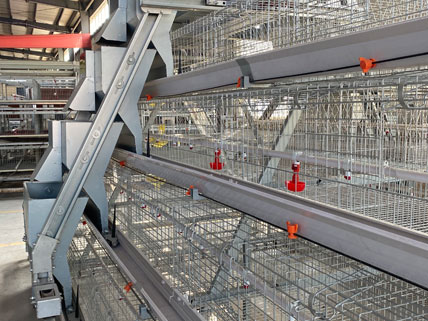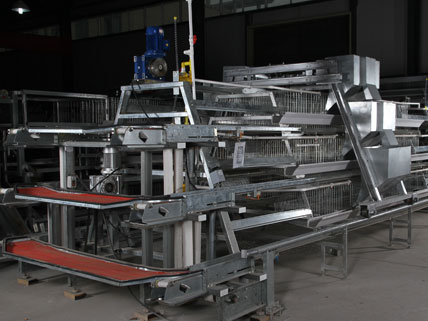How Many Hours Of Sunlight Do Chickens Need To Lay Eggs
During the laying cycle of laying hens, especially in the peak laying period of laying hens, the requirements for light intensity and light time are very strict. When necessary, artificial light is required. The lighting requirements of laying hens at different stages are different. During the laying period of chickens, it is necessary to maintain stable light, and it is strictly forbidden to shorten the light time.
Light intensity and light time requirements for laying hens during the laying period
The light intensity of the chicken house
The light intensity in the chicken house must be suitable, generally, 10-20 lux (3-4 watts/m2) is appropriate. The light distribution should be uniform, and no blind spots should be left. If the light is too dark, it will be unfavorable for the chickens to lay eggs and will reduce the egg production of the laying hens. If the light is too strong, the chickens will appear nervous, easily startled, and often fight with each other. The light source is generally installed above the aisle, 2 meters away from the ground, and the light bulb is an ordinary incandescent lamp with a power of 15-60 watts.
The light time of the chicken house
The closed chicken house can artificially control the light so that the chicken can fully exert its egg production potential, which is one of the main reasons for the higher egg production in the closed chicken house. Open chicken houses are affected by natural light. The duration of natural light varies greatly from season to season. To ensure the light needs of laying hens, it is necessary to formulate a management system for artificial light supplementation according to the natural lighting laws in different seasons and different regions. The supplementary light should be gradually increased by half an hour (not more than 1 hour) every week until the full 16 hours, and continue until the end of egg-laying. There must be 8 hours of continuous darkness at night to ensure that the chicken can recover physiologically and avoid excessive fatigue. Light leakage during dark hours should be avoided.
Artificial light supplement
The supplementary light can be supplied before dawn, or all of it can be supplied after sunset, half before dawn, and a half after sunset. Because some chickens are more active in the morning, and some chickens are more active in the evening, the artificial lighting effect can be improved by using the method of supplementing light in the morning and evening.
Characteristics of light requirements of laying hens at different stages
The reproductive system of chicks before 10 weeks of age is less sensitive to light. To facilitate the management, the light can be appropriately longer in the first few days. Natural light can be used in the future.
The reproductive system of chicks between 10 to 20 weeks is gradually sensitive to light. To prevent precocious puberty and ensure that the bodyweight is reached, it is necessary to strictly control the light, and it must be constant within a standard.
The 20-week-old chicks should gradually extend the light time to stimulate the development of the gonads and prepare for the timely start of egg production. For flocks that do not reach the norm weight, light can be added 12 weeks later. At the same time, feed supply should be increased, but not later than 22 weeks of age at the latest. Generally, it will be extended by about 1 hour per week, and the daily light time will reach a fixed specification when the production starts, and it will remain constant thereafter until the caged chicken is released. The reproductive system of chickens is particularly sensitive to light after 16 weeks. Light management during this period is very important. It is related to whether the flock can start production at the right time. Do not increase the light too early or too fast, otherwise it is easy to cause premature birth, and it will cause the chicken to prolapse and peck the anus.
Lighting plan according to the conditions of the chicken house.
The principle of light control: About 8 hours of light a day in the growth period is the best, no more than 11 hours. For the open chicken house, the light time should not be extended (especially after 12 weeks of age), and the illumination should be 5~ 10lx is appropriate.
Closed Chicken House
The chickens raised in chicken cages in the closed chicken house are completely illuminated by artificial light, and the light intensity and time can be controlled artificially, so it can be accurately implemented according to the prescribed system. Daily light time can be set at 8 hours. The chicks were exposed to light for 23 to 24 hours a day within 1 week of age, and 8 hours of light per day for 2 to 20 weeks of age.
Artificial light is used for chicken flocks, 8 hours of light at 20 weeks of age, 1 hour per week at 21 to 24 weeks of age, and 0.5 hours after 25 weeks to 16 hours at 32 weeks of age.
Laying hens in the open chicken house
If it is bred in a closed house, it will be transferred to an open house when the eggs are laid. If the natural light time at that time is less than 12 hours, 12 hours of light should be given immediately; if the natural light time at that time is longer than 12 hours, it will be increased by 0.5 hours per week until the laying hen light time is 16 hours.
Lighting plan according to the seasonal conditions
Chicks hatched in spring and summer
Spring and summer chicks are in a short period of natural light in the later stages of growth and enter the laying period when the flock lays the first egg. The artificial light can be added for 0.5 to 1 hour every week, and the light should reach the specified time for laying hens when the flock is 30 weeks old.
Autumn and winter chicks
In the later period of the growth stage, the hours of sunshine are getting longer. If the natural light is fully utilized, it will usually stimulate the hens to accelerate the development of sexual organs and make them prematurely mature and senile. To prevent this from happening, artificial lighting is often used to achieve a constant or gradual reduction of the lighting time.
Use the shading method to limit the lighting time
The shading method is to control the natural light for the open chicken house. Install roller shutters on the doors, windows, and other light-transmitting places of the chicken house to completely cover the chicken house to form a dark room. Roll up or lower the curtains regularly every day, so that natural light can be controlled. within the required range. The lighting time is completely the same as that of the closed chicken house, except that natural light is used instead of artificial light.
The number of light hours remains constant
Change the duration of natural light gradually longer into a steady longer light time. From the day of hatching, according to the local sunrise and sunset time, find out the natural sunshine hours of the longest day within 20 weeks of age. Increase by 0.5 to 1 hour per week until the light is 16 hours in the laying period.

 Rre
Rre







Post your divine reply